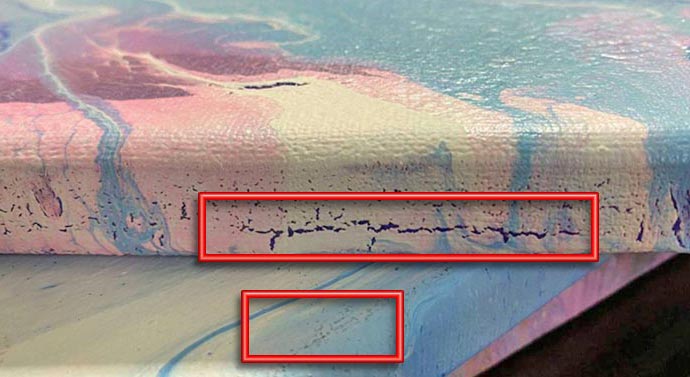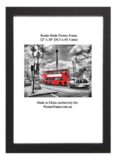![]() We will begin this blog post on stretching acrylic paintings by reminiscing with the older cohort of us who might recall the eponymous, mid 1980's Castrol oil company's advertisements featuring Sol, the Mafia Don, and his mafiosi confederates.
We will begin this blog post on stretching acrylic paintings by reminiscing with the older cohort of us who might recall the eponymous, mid 1980's Castrol oil company's advertisements featuring Sol, the Mafia Don, and his mafiosi confederates.  We were darkly warned that not all engine oils were the same, even though they may have smelled and looked the same. To same extent, the same applies to many paintings on canvas that we see coming through our picture framing workship. The catalyst for the creation of this post, once again was sparked by one of our Customers. The gentleman in question had just brought back from Indonesia a large, colourful, expensive "oil" painting which he wanted stretched on a stretcher frame and float framed. On inspecting the painting on our framing counter during the custom ...
We were darkly warned that not all engine oils were the same, even though they may have smelled and looked the same. To same extent, the same applies to many paintings on canvas that we see coming through our picture framing workship. The catalyst for the creation of this post, once again was sparked by one of our Customers. The gentleman in question had just brought back from Indonesia a large, colourful, expensive "oil" painting which he wanted stretched on a stretcher frame and float framed. On inspecting the painting on our framing counter during the custom ...
picture framing consultation, and on handling the art, we noticed that it did not smell at all. Immediately we surmised that the painting was painted with acrylic, rather than oil paint. Paintings rendered with genuine oil paint and imbued with turpentine have a very, strong, sometimes dizzying, distinctive smell.
If you have ever been inside a house where the painters have just finished painting the woodwork, you will recognize and remember, the strong, oily smell which can take days, if not weeks, to dissipate. With the the Customer's acrylic painting, just to make sure, we tested one of the edges, which when folded at 90 degrees, began crumbling and cracking as exemplified in the image below:

As soon as we realized why and what was happening with this particular painting, we informed the Customer who then instructed us to have his painting mounted and framed normally, rather than stretched and float-frame, as originally planned.
But, to return to the crux of this matter, the stretching of acrylic paintings, you might well ponder, why do artists paint using acrylics if this is what can happen? Alas, the reasons are varied and complex. We discussed this issue with a couple of our artists Customers we know, and below is a synopsis of the whys and wherefores some prefer acrylics to oils, and vice-versa.
With regard to the stretching acrylic paintings, there are advantages and disadvantages with using both media and since artists can have wide and varied preferences, many cite the varying factors and qualities of each paint medium that they prefer or like best. The two paints are unlike one another and have quite different properties and characteristics.
Acrylic Paints: These are a relatively new, 20th century invention. Many artists like this medium because it dries quicker, the brushes uses to paint with can be washed with water, though generally, the paint itself is not as long lasting as oil paints. Acrylics dry in a day or so and additional work or layers can be added, applied and worked on much more quickly than oil.
Acrylics are more versatile than oils because these can be used not only on canvases or boards but also on or with paper and fabrics. If necessary, they can even suit outdoors usage when for impermanent use.
For outdoors, however, specialty outdoor paints should be considered as these can provide greater durability to withstand inclement weather exposure such as strong sun and rain. Again, as these dry quicker than oil, many artists find this factor quite important and convenient.
They maybe working on a larger canvas, wanting to applying several layers, either on top or by way of overlap, and each preceding coat should dry before another is rendered. While water-based acrylics do speed up the drying process quicker than the more expensive alternatives, these do emit some vapours and fumes which still need to be ventilated, especially in confined spaces or rooms.
This is because some brands are known to contain ammonia, which, even though it is in small amounts, for safety and health reasons, should not be inhaled, but expelled, or ventilated away.
On the subject of stretching acrylic paintingsIt was also mentioned to us that certain artists also prefer acrylic paints because these render crisper edges for raised, deeper and even, slightly 3-dimensional creations. Seamless and smooth blends can be difficult to achieve with acrylics because of the fast hardening of the paint, especially on the larger canvases.
A tip to slow down to drying time for acrylics is to add and additive or medium which might be a retardant, gloss gelatine or liquid glazing gloss. The glazing gloss can be mixed with the matting agent when still wet, which is somewhat opaque, rather than a brilliant or shiny gloss.
These paints can also be quite flexible and and some artists use them with a palette knife to create chunky impasto paintings which, even if thick and raised, will dry.
On the plus side, and unlike oil paints, acrylic are generally lightfast. These do not fade away with the passing of time time, and will look as fresh and vibrant in 100 years time as the day these were created. There are no oils in acrylic polymers and these cannot bleach or yellow over time.
Oil Paints: Oil paints have a much longer history than acrylics. Since the Renaissance, most famous oil paintings, such as Mona Lisa, The Starry Night, Girl with a Pearl Earring, The Kiss, Impression, Sunrise, Guernica, The Persistence of Memory, Whistler's Mother, to name but a few, all were rendered in oil.
Working with oil paint and to finish one completely can be a lengthy process as it dries quite slowly compared to its cheaper alternative. Some of the white oxides can take as long as two years to dry although most can be re-applied or reworked in a few weeks or months.
True, with the correct type, brand and medium, some can touch-dry in half an hour or so, but generally these do take at least a day and longer because of the thicker, denser and oilier composition. It can also be difficult to work quicker without weakening the works, structure and strength.
However these are more durable since their oily base makes it adhere better to most canvases or well-primed boards resulting in enhanced durability. As to its longevity, or durability, if varnished and preserved correctly an oil painting can last more than, and well over, 100 years, whereas acrylic only tend to last only about a third of that time.
Another relative advantage with oil paints is that they remain wet far longer acrylics. This gives artists more time and the versatility to stop-start work on a painting from one day to the next. Importantly, any oils on the palette do not dry up but remain soft and elastic thus allowing the immediate or delayed mixing and blending of colours.
On subject of oil in oil paints, most artists prefer to buy pre-primed boards or canvases to paint on. This is largely due to the fact that preparing a canvas with linseed oil is time consuming, whereas ready-to-paint, primed boards and canvases are relatively inexpensive and obviate time-consuming canvas, or board preparation work.
When painting in and with oil paint, having to use drying oils, linseed oil, mineral turpentine, or white spirit, and thinners is often necessary. Unfortunately, these have very strong smell which not everyone can tolerate.
Artists use these materials in well-ventilated places and are also very careful about smoking ( although Vincent Van Gough believed smoking his pipe helped his artistic creativity ) because all are quite flammable and may actually self-ignite or spontaneously self-combust especially in dry, hot weather.
Oil paints do not generate immediate colour shifts ( an evident and noticeable change in light spectral output ) and initially, when painted on canvases, their colour rendition is stable. However, as the paint dries, colours will change somewhat when these bed in or ‘sink in’ into the surface being painted. Nevertheless, this can often be remedied by 'oiling oil out’ the affected area or areas.
Cost : Many artists do not leave a life of luxury and often, if being solely a full time artist, they eke out a living as best as they can. They are very careful as to how to spend their money and carefully watch the cost materials, paints boards and canvases. They will economize as best, as often, and as much as they can, which makes sense, considering their precarious financial situation. The paint pricing (in USD ) table below, show the relative costs of painting using acrylics paints:

and the paint pricing (in USD ) table below, show the relative costs of painting using oil paints:

Aside from the above pricing differences and the previously mentioned, differing drying times, some artists have also commented to us that oil paint can be fatiguing and more difficult to paint with as it tends to be heavier, thicker and denser. Yet others are of the opinion that for all its drawbacks, oil-based paint have much smoother consistencies and superior pigmentation than acrylics.
By way of summary of all the above feedback and information we received and presented here, we conclude that each artist maintains personal choices and preferences developed according to and with his or her professional training and artistic careers.
Let us however, go back to the main topic of this post, the stretching of acrylic paintings. And this was that many of the acrylic paintings Customers bring back from overseas to be safely stretch-framed. This is because when pulling, tightening and stretching the canvas fabric over the stretcher frame, the paint can, and often does, crack and flake off along the four edges of the stretcher frame. Below is an additional example:

And a last example of paint cracking and flaking is shown under here:

Perhaps a penultimate point with the stretching of some acrylic paintings that needs mentioning is that, in some cases, the paint is so thickly applied that it badly puckers up the canvas, making it impossible for picture framers to tighten and stretch it. The photograph below shows marked and prominent horizontal wrinkles badly puckering the canvas whilst attempting to stretch it on a stretcher frame.

In extreme cases, such as the example above, the only solution is not to try and stretch the canvas but instead, to glue it down and then vacuum press it. This is the method that we found best in framing wrinkled, creased, crinkled and dog-eared artwork which can include canvases, paintings, photographs, maps, photo, posters, prints etc. The process is called cold mounting and in 99% of he cases results in a very flat, even, uniform, durable and permanent adhesion of the art to a backing board.
Naturally this method is suggested only when framing inexpensive, commercial, disposable or ephemeral, cheap art which is of little value to the Customers. Should this not be the case, then we would not permanently glue down the art but we would contemplate stretch-framing because this is a reversible process. Alternatively, for valuable, historical or important works, we would suggest consulting an art conservator or fine arts professional.
Lastly, it is always worthwhile to consider more economical alternatives to the custom framing and stretching acrylic paintings, whether the paintings be painted with acrylic or oil paints. If a painting happens to be of a common or standard size such as ready-made picture frames A0, A1 or A2 , some Customers use them to put their artwork in, because the price is often 1/3rd to 1/2 to that of custom frames.
While the end result may not be quite as neat and attractive to that of custom framing, it is up to Customers to choose and decide. Thank you for reading this post discussing the different aspects, issues and problems of stretching acrylic paintings. Thank you for reading our post about: " Stretching acrylic paintings."









Righto! So that’s why those big Balinese paintings are cheap, they’re using wall paint instead of quality artist’s oils? And that’s why they sell them to you rolled up in a tube and it’s only why you unroll them back in Australia that the problems with the paint and canvas cracking start !